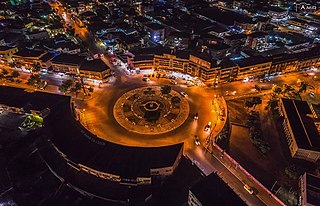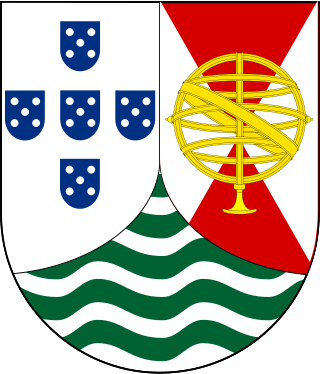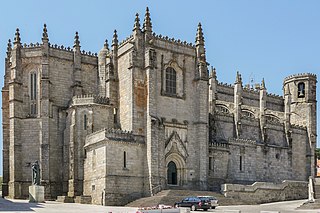| History of Mozambique |
|---|
 |
The following is a timeline of the history of the city of Beira, Mozambique.
| History of Mozambique |
|---|
 |
The following is a timeline of the history of the city of Beira, Mozambique.

Portuguese Mozambique or Portuguese East Africa were the common terms by which Mozambique was designated during the period in which it was a Portuguese colony. Portuguese Mozambique originally constituted a string of Portuguese possessions along the south-east African coast, and later became a unified colony, which now forms the Republic of Mozambique.

Nampula is the capital city of Nampula Province in Northern Mozambique. With a population of 743,125, it is the third-largest city in Mozambique after Maputo and Matola. The city is located in the interior of Nampula Province, approximately 200 kilometers from the coast and is surrounded by plains and rocky outcrops. The city is a major regional centre for the entire Northern region of Mozambique, as well as parts of Central Mozambique and border areas of Malawi and Tanzania.

Beira /ˈbei̯ɾɐ/ is the capital and largest city of Sofala Province, in the central region of Mozambique.

José Craveirinha was a Mozambican journalist, story writer and poet, who is today considered the greatest poet of Mozambique. His poems, written in Portuguese, address such issues as racism and the Portuguese colonial domination of Mozambique. A supporter of the anti-Portuguese group FRELIMO during the colonial wars, he was imprisoned in the 1960s. He was one of the African pioneers of the Négritude movement, and published six books of poetry between 1964 and 1997. Craveirinha also wrote under the pseudonyms Mário Vieira, José Cravo, Jesuíno Cravo, J. Cravo, J.C., Abílio Cossa, and José G. Vetrinha.

The Catholic Church in Mozambique is part of the worldwide Catholic Church, under the spiritual leadership of the Pope in Rome.

The Grande Hotel Beira is an abandoned luxury hotel in Beira, Mozambique. It was opened in 1954 and operated until 1974, when it was closed due to lack of guests. The building was used as a military base during the Mozambican Civil War. It is currently home to over 3,500 squatters.

The Port of Beira is a Mozambican port located in the city of Beira, capital of the Sofala Province. It is located in Sofala Bay, which forms a huge complex with the mouth of the Pungoe River, known as the Beira estuary, facing the Mozambique Channel. It is the second largest port in Mozambique, built to replace the port of Old Sofala in the 1890s.

The Mozambique Company was a royal company operating in Portuguese Mozambique that had the concession of the lands in the Portuguese colony, corresponding to the present provinces of Manica and Sofala in central Mozambique.

Guarda is a city and a municipality in the District of Guarda and the capital of the Beiras e Serra da Estrela sub-region in central Portugal. The population in 2021 was 40,126, in an area of 712.10 square kilometres (274.94 sq mi) with 31,224 inhabitants in the city proper in 2006. Founded by King Sancho I in 1199, Guarda is the city located at the highest altitude in Portugal and one of the most important cities in the Portuguese region of Beira Alta. Serra da Estrela, the highest mountain range in continental Portugal, is partially located in the district. The city is served by national and international trains on the Beira Alta and Baixa railway lines. The present mayor is Sérgio Costa, as an independent. The municipal holiday is November 27.
The following is a timeline of the history of the city of Lisbon, Portugal.
Sebastião Soares de Resende was a Portuguese Catholic bishop in Africa at the head of the diocese of Beira in Mozambique. He was the most liberal of the first generation of bishops after the 1940 Concordat. He is famous for having openly criticised, in the name of the social doctrine of the church, both forced labour and forced cultivation in Mozambique. In the 1960s he leaned towards the idea that Mozambique should become independent.
The following is a timeline of the history of the city of Maputo, Mozambique.

The Our Lady of the Rosary Cathedral also called Metropolitan Cathedral of Our Lady of the Rosary, is located in Beira, a town in the African country of Mozambique and is the cathedral of the Archdiocese of Beira.
The following is a timeline of the history of the city of Porto, Portugal.
The following is a timeline of the history of the city of Braga, Portugal.
The following is a timeline of the history of the city of Coimbra, Portugal.
The following is a timeline of the history of the municipality of Setúbal, Portugal.
The following is a timeline of the history of the city of Porto Alegre, in the state of Rio Grande do Sul, Brazil.
The following is a timeline of the history of the city of Belém, in the state of Pará, Brazil.